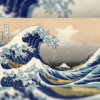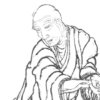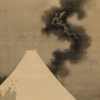Shimomura Kanzan
| NAME | Shimomura Kanzan / 下村観山 |
| BIRTH & DEATH | 1873-1930 |
| BIRTHPLACE | Wakayama pref. |
| PEN NAME | 北心斎東秀, 観山 |
| MASTER | Kanō Hōgai, Hashimoto Gahō, Okakura Tenshin |
| POSITION |
|
| RECORD OF AWARDS |
, etc |
| NOTE |
DESCRIPTION
Shimomura Kanzan (下村観山, 1873-1930) was a Japanese-style painter. Teishitsu Gigeiin (Imperial art expert). Born in Wakayama pref. Pupil of Kanō Hōgai and Hashimoto Gahō. Graduated in the first class of the Tokyo Bijutsu Gakko (Tokyo School of Fine Arts); later taught there until he resigned in 1898. Except for a period in Europe from 1903 to 1905, worked with Hishida Shunsō and Yokoyama Taikan under the leadership of Okakura Tenshin to establish and maintain the Nihon Bijutsuin and the revival of Japanese-style painting. Showed constantly with the Inten. With Taikan, was considered one of the best artists of this group. Member of the Art Committee of the Imperial Household. His subject matter from Japanese legend and history; known for his line drawings inspired by the 12th-century scrolls from the Kozan-ji. One of the three painters commissioned to make the copy of the Amida Raigo at Koyasan. Painted landscapes and kachoga (bird-and-flower painting) in a delicate, colorful, competent Kanō style, with traces of Western-inspired realistic detail and considerable Rinpa influence. A fine draftsman.
One of his representative works is a byobu screen titled Yoroboshi or “The Beggar Monk” was created in 1915 in colored ink and gold leaf on paper. It is currently housed in the Tokyo National Museum, and is registered as an Important Cultural Property by the Agency for Cultural Affairs. The screen depicts a scene from a famous Noh play of the same name. In the scene, blind monk, has been falsely accused of a crime. Disowned by his family he wanders about, living as a vagrant. Although he is now blind, he has become one with the universe and can see all that surrounds him. Kanzan borrowed heavily from Momoyama period and Edo period style and composition, and the work shows a strong Rinpa influence.
« Back to Index









